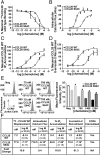Protein engineering of the chemokine CCL20 prevents psoriasiform dermatitis in an IL-23-dependent murine model
- PMID: 29109267
- PMCID: PMC5703275
- DOI: 10.1073/pnas.1704958114
Protein engineering of the chemokine CCL20 prevents psoriasiform dermatitis in an IL-23-dependent murine model
Abstract
Psoriasis is a chronic inflammatory skin disease characterized by the infiltration of T cell and other immune cells to the skin in response to injury or autoantigens. Conventional, as well as unconventional, γδ T cells are recruited to the dermis and epidermis by CCL20 and other chemokines. Together with its receptor CCR6, CCL20 plays a critical role in the development of psoriasiform dermatitis in mouse models. We screened a panel of CCL20 variants designed to form dimers stabilized by intermolecular disulfide bonds. A single-atom substitution yielded a CCL20 variant (CCL20 S64C) that acted as a partial agonist for the chemokine receptor CCR6. CCL20 S64C bound CCR6 and induced intracellular calcium release, consistent with G-protein activation, but exhibited minimal chemotactic activity. Instead, CCL20 S64C inhibited CCR6-mediated T cell migration with nominal impact on other chemokine receptor signaling. When given in an IL-23-dependent mouse model for psoriasis, CCL20 S64C prevented psoriatic inflammation and the up-regulation of IL-17A and IL-22. Our results validate CCR6 as a tractable therapeutic target for psoriasis and demonstrate the value of CCL20 S64C as a lead compound.
Keywords: CCL20; Th17; X-ray; protein engineering; psoriasis.
Conflict of interest statement
Conflict of interest statement: B.F.V. and F.C.P. have ownership interests in Protein Foundry, LLC. The other authors state no conflict of interest. The technology presented is protected under provisional patent filing no. 62/170,347.
Figures




References
-
- Parisi R, Symmons DP, Griffiths CE, Ashcroft DM. Identification and Management of Psoriasis and Associated ComorbidiTy (IMPACT) Project Team Global epidemiology of psoriasis: A systematic review of incidence and prevalence. J Invest Dermatol. 2013;133:377–385. - PubMed
-
- Baba M, et al. Identification of CCR6, the specific receptor for a novel lymphocyte-directed CC chemokine LARC. J Biol Chem. 1997;272:14893–14898. - PubMed
-
- Liao F, et al. CC-chemokine receptor 6 is expressed on diverse memory subsets of T cells and determines responsiveness to macrophage inflammatory protein 3 alpha. J Immunol. 1999;162:186–194. - PubMed
-
- Homey B, et al. Up-regulation of macrophage inflammatory protein-3 alpha/CCL20 and CC chemokine receptor 6 in psoriasis. J Immunol. 2000;164:6621–6632. - PubMed
Publication types
MeSH terms
Substances
Associated data
- Actions
Grants and funding
LinkOut - more resources
Full Text Sources
Other Literature Sources
Medical
Molecular Biology Databases

